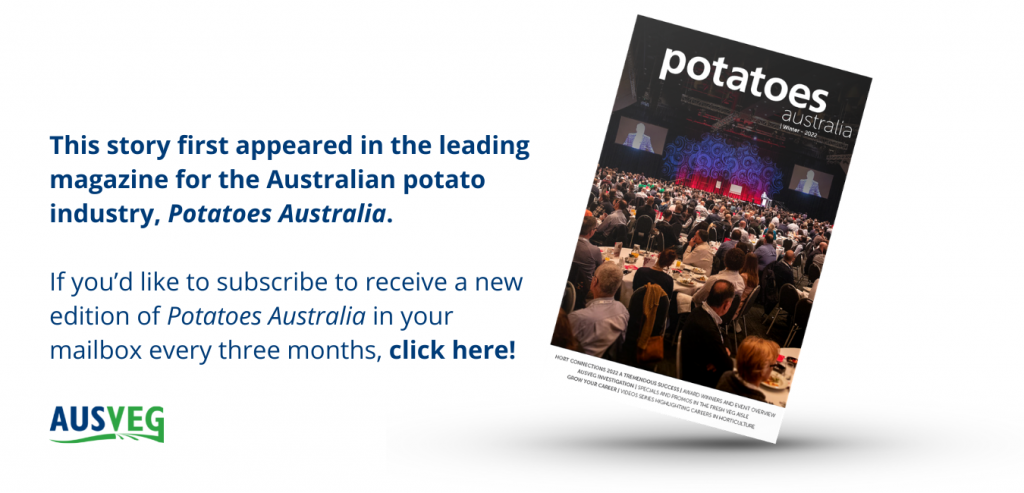
Shining a light on careers in Australian horticulture
12 August 2022
Potato yield grows year-on-year with MIRAVIS® Prime fungicide
12 August 2022Year Published
2022
Issued: 7 July 2022
Summary
- August to October rainfall is likely to be above median for most parts of Australia away from the west, with below median rainfall likely for western Tasmania and part of south-western Western Australia.
- August to October maximum temperatures are likely to be above median for northern, and far southern parts of Australia, but below median for parts of eastern Australia.
- Minimum temperatures for August to October are likely to be warmer than median Australia wide.
- A developing negative Indian Ocean Dipole, along with warmer than average waters around northern Australia, and neutral phase of the El Niño–Southern Oscillation during winter, are likely to be influencing this outlook.
Rainfall: Wetter August to October likely for most of Australia away from the west
- August to October rainfall is likely to be above median for eastern WA, the NT, SA, Queensland, NSW, northern and central Victoria, and eastern Tasmania (chance of exceeding the median is greater than 60 per cent), with much of the NT, Queensland and NSW very likely to be above median (greater than 80 per cent chance). However, rainfall is likely to be below median in western Tasmania and part of south-western WA (chances of exceeding the median are less than 40 per cent).
- Large parts of northern, central, and eastern mainland Australia (away from the southern coastline) are around 2 to 3.5 times more likely than average to have unusually high (in the top 20 per cent wettest of all years over 1981–2018) rainfall for August to October.
- The August and September monthly outlooks are broadly similar to the three-month outlook, although the chances of above median rainfall are slightly less emphatic. August has slightly more widespread chances of drier conditions across south-west WA, south-east NSW into south-west Victoria and western Tasmania.
- It should be noted that May to September is the northern Australian dry season. This means tropical northern Australia typically has very low rainfall totals during this time (large areas less than 25 mm for the season), and only a small amount of rainfall is needed to exceed the median.
- Past accuracy for August to October rainfall is moderate to high for most areas of Australia, but low for inland southern WA extending into southern SA, with low accuracy also for southern Tasmania.
Temperature: Warmer August to October days likely for north and far south, cooler days for east
- August to October maximum temperatures are likely to be above median for the northern tropics, southern WA, south-east SA, most of Victoria extending into south-east NSW, and Tasmania (greater than 60 per cent chance). Below median maximum temperatures are likely for much of southern Queensland and much of northern and central NSW (chance of exceeding the median is less than 40 per cent).
- There is an increased chance of unusually high maximum temperatures (in the top 20 per cent of historical records) for August to October over the northern tropics, south-west WA, far south-east SA, southern Victoria and Tasmania (1.5 to greater than 4.0 times the usual chance).
- Minimum temperatures for August to October are likely to be warmer than median Australia wide (chances greater than 60 per cent), with the eastern two-thirds of Australia very likely to be warmer than median (chances are greater than 80 per cent).
- There is an increased chance of unusually high minimum temperatures (in the top 20 per cent of historical records) for August to October across almost all of Australia (1.5 to greater than 4.0 times the usual chance). The highest chance of unusually warm minimum temperatures is across the northern tropics.
- Past accuracy for August to October maximum temperatures is moderate to high for most areas of Australia, and very high for parts of the tropical north, south-east, and western parts of Australia. For minimum temperatures, accuracy is moderate to high across most of Australia, with low to very low accuracy across north-west WA; some parts of the tropical north and Tasmania have very high accuracy.
For more information, visit bom.gov.au/climate/outlooks/.
Article
Environment
Potatoes
Solanaceous vegetables


